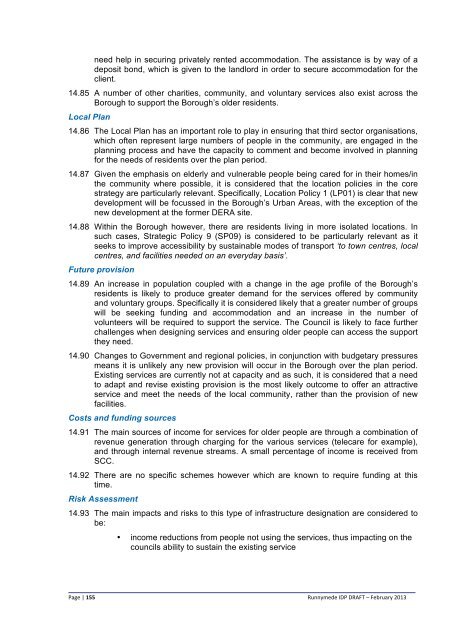Infrastructure Delivery Plan (Feb 2013) - Runnymede Borough Council
Infrastructure Delivery Plan (Feb 2013) - Runnymede Borough Council
Infrastructure Delivery Plan (Feb 2013) - Runnymede Borough Council
You also want an ePaper? Increase the reach of your titles
YUMPU automatically turns print PDFs into web optimized ePapers that Google loves.
need help in securing privately rented accommodation. The assistance is by way of a<br />
deposit bond, which is given to the landlord in order to secure accommodation for the<br />
client.<br />
14.85 A number of other charities, community, and voluntary services also exist across the<br />
<strong>Borough</strong> to support the <strong>Borough</strong>’s older residents.<br />
Local <strong>Plan</strong><br />
14.86 The Local <strong>Plan</strong> has an important role to play in ensuring that third sector organisations,<br />
which often represent large numbers of people in the community, are engaged in the<br />
planning process and have the capacity to comment and become involved in planning<br />
for the needs of residents over the plan period.<br />
14.87 Given the emphasis on elderly and vulnerable people being cared for in their homes/in<br />
the community where possible, it is considered that the location policies in the core<br />
strategy are particularly relevant. Specifically, Location Policy 1 (LP01) is clear that new<br />
development will be focussed in the <strong>Borough</strong>’s Urban Areas, with the exception of the<br />
new development at the former DERA site.<br />
14.88 Within the <strong>Borough</strong> however, there are residents living in more isolated locations. In<br />
such cases, Strategic Policy 9 (SP09) is considered to be particularly relevant as it<br />
seeks to improve accessibility by sustainable modes of transport ‘to town centres, local<br />
centres, and facilities needed on an everyday basis’.<br />
Future provision<br />
14.89 An increase in population coupled with a change in the age profile of the <strong>Borough</strong>’s<br />
residents is likely to produce greater demand for the services offered by community<br />
and voluntary groups. Specifically it is considered likely that a greater number of groups<br />
will be seeking funding and accommodation and an increase in the number of<br />
volunteers will be required to support the service. The <strong>Council</strong> is likely to face further<br />
challenges when designing services and ensuring older people can access the support<br />
they need.<br />
14.90 Changes to Government and regional policies, in conjunction with budgetary pressures<br />
means it is unlikely any new provision will occur in the <strong>Borough</strong> over the plan period.<br />
Existing services are currently not at capacity and as such, it is considered that a need<br />
to adapt and revise existing provision is the most likely outcome to offer an attractive<br />
service and meet the needs of the local community, rather than the provision of new<br />
facilities.<br />
Costs and funding sources<br />
14.91 The main sources of income for services for older people are through a combination of<br />
revenue generation through charging for the various services (telecare for example),<br />
and through internal revenue streams. A small percentage of income is received from<br />
SCC.<br />
14.92 There are no specific schemes however which are known to require funding at this<br />
time.<br />
Risk Assessment<br />
14.93 The main impacts and risks to this type of infrastructure designation are considered to<br />
be:<br />
• income reductions from people not using the services, thus impacting on the<br />
councils ability to sustain the existing service<br />
Page | 155<br />
<strong>Runnymede</strong> IDP DRAFT – <strong>Feb</strong>ruary <strong>2013</strong>
















